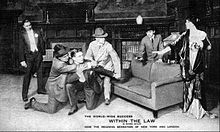Within the Law (play)
| Within the Law | |
|---|---|

Advertising postcard for Within the Law
|
|
| Written by | Bayard Veiller |
| Date premiered | September 11, 1912 |
| Place premiered | Eltinge 42nd Street Theatre |
| Original language | English |
| Genre | Drama |
Within the Law is a play written by Bayard Veiller. It is the story of a woman who is wrongly accused of stealing and sent to prison. Upon her release, she sets up a gang that engages in shady activities that are just "within the law". After the police try to entrap her, she is mistakenly accused again, this time for murder, but she is vindicated when the real killer confesses.
Veiller used his experience as a crime reporter to develop the play, but he was initially unable to find a producer for it. He finally settled on selling the rights to the play, along with two others he had written, for a fixed fee. After an unsuccessful run in Chicago, it became a huge hit on Broadway in 1912–1913, running for 541 performances. It was subsequently performed by multiple road companies and adapted as a movie five times. Although it was one of the biggest hits of its era, Veiller got relatively little income from it due to his decision to sell it for a lump sum.
In the first act, word comes to the department store owner Edward Gilder that one of his former sales clerks, Mary Turner, has been convicted for stealing and given a three-year prison sentence. Gilder is pleased because he had asked the judge to make her an "example" to other employees. Turner asks to speak with Gilder before she goes to prison. While Gilder waits for her arrival, his store detective detains another woman, a customer, for stealing. This woman is the wife of a prominent banker, so rather than have her arrested, Gilder apologizes to her and lets her go. Turner arrives and tells Gilder she has been wrongly convicted. Although she says she never stole, she pleads with Gilder to increase the wages of his clerks, so no one who works there will be forced to steal. Gilder rejects her arguments, and she leaves for prison swearing revenge on him for his treatment of her.
Upon getting out of prison, Turner sets up a gang that engages in shady activities that are just within the boundaries of the law. She also marries Gilder's son. A member of the gang attempts to rob the home of Turner's new father-in-law at the urging of a police stooge attempting to entrap the gang. When the stooge reveals the plot, the gang member kills him, leaving Turner and her new husband at the scene to be found by the police. It seems that Turner may go to prison again, but she is saved when the guilty party confesses that she had no involvement in the crimes.
Veiller began writing the play under the title The Miracle, which he later revised to The Case of Mary Turner and finally to Within the Law. In 1911 he took it to the Selwyn brothers (Archie and Edgar Selwyn), who brokered plays, to find a producer for it. Several prominent producers considered it, including David Belasco, George M. Cohan, Charles Frohman, Sam Harris, and Henry Wilson Savage. It was repeatedly rejected. The production duo of Louis Dreyfus and Herman Fellner took an option on the play, but they ran into financial difficulties and the option lapsed. Seeing few prospects for his work, Veiller offered to sell the rights to Within the Law and two other plays to the Selwyns for a flat fee of $3,750 (about $566,000 in 2015 dollars). They were reluctant to accept this offer, fearing that they would be seen as exploiting an author in financial difficulty, but they eventually agreed.
...
Wikipedia
